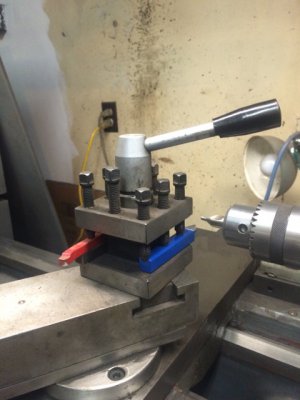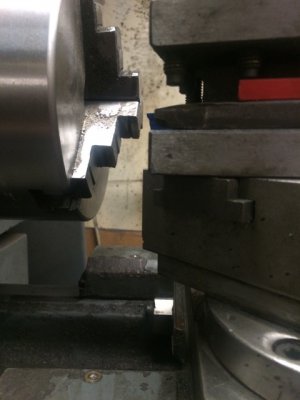Attached are some pictures of the tool post on my Force International 1440.
From all my reading, both books and on the internet, the height of the cutting edge is pretty critical, it should be pretty much right on the centerline of the lathe.
From what I can tell, there is NO way to adjust the height on this toolpost. I'm considering grinding a shim to put under the tool, but that just gets me in the ballpark and it would be a shim/tool which IMHO would be ridiculous. The blue tool a 1/2" cutter and it is about 1/4" too low.
I understand I can buy a replacement toolpost that has an explicit height adjustment, but given that the height of the cutting tip being critical, to within a fraction of an inch, what is the point of a toolpost like this one? Is it just that this toolpost assumes that I buy only tools that wind up at EXACTLY the right height? Or that it's just shim-city?
I can understand that maybe it would make the lathe a little more expensive to have a large adjustment, like even 1/4", but not that it has NO (at least that I can see) adjustment at all.
How the heck do I adjust the height?


From all my reading, both books and on the internet, the height of the cutting edge is pretty critical, it should be pretty much right on the centerline of the lathe.
From what I can tell, there is NO way to adjust the height on this toolpost. I'm considering grinding a shim to put under the tool, but that just gets me in the ballpark and it would be a shim/tool which IMHO would be ridiculous. The blue tool a 1/2" cutter and it is about 1/4" too low.
I understand I can buy a replacement toolpost that has an explicit height adjustment, but given that the height of the cutting tip being critical, to within a fraction of an inch, what is the point of a toolpost like this one? Is it just that this toolpost assumes that I buy only tools that wind up at EXACTLY the right height? Or that it's just shim-city?
I can understand that maybe it would make the lathe a little more expensive to have a large adjustment, like even 1/4", but not that it has NO (at least that I can see) adjustment at all.
How the heck do I adjust the height?


